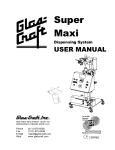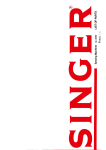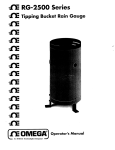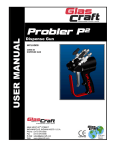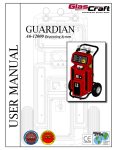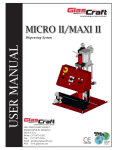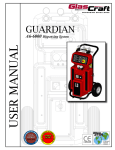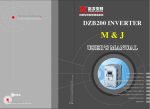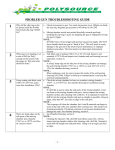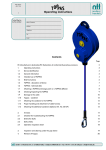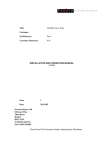Download Probler Gun Troubleshooting Guide
Transcript
CONTENTS SAFETY 1 SYSTEM TROUBLESHOOTING GUIDE CHART 26 PROBLER GUN ILLUSTRATION AIR PASSAGE & THREAD ILLUSTRATION DAILY START-UP DAILY SHUT-DOWN SEAL and VALVE INTEGRITY TESTS SEAL INSPECTION CHAMBER DRESSING PISTON THROW ADJUSTMENT 4 5 6 6 7 8 9 10 TROUBLESHOOTING GUIDE 11 ELECTRICAL TROUBLESHOOTING GUIDE HEATER FIREROD SPECIFICATIONS THERMOCOUPLE SPECIFICATIONS WATLOW ERROR CODE CHART GENERATOR CONVERSION 28 28 29 29 Notes 30 LS GUN ILLUSTRATION INITIAL START-UP SPRAY TECHNIQUE DAILY SHUT-DOWN EXTENDED SHUT-DOWN 14 15 16 17 17 MATERIAL PUMPS 19875-00 ILLUSTRATION 21835-00 IILUSTRATION 18 19 OVERHAUL PROCEDURE TROUBLESHOOTING CHART OVERPRESSURE SWITCH INSTALLATION 20 22 24 IF YOU HAVE AN EQUIPMENT PROBLEM… INSIDE BACK COVER Basic Troubleshooting Guide__________________________________________________________ SAFETY Operating Safely Safe Handling And Use of Urethane Foam Equipment In operating urethane foam equipment safely, user should make every effort to: 1. Handle chemicals safely. 2. Provide adequate ventilation. 3. Provide adequate safety equipment (gloves, respirators, safety glasses, protective clothing, etc.) for operators and all others working in areas where they may be exposed to the chemicals or their vapors. 4. Avoid operating equipment which has given any indication of malfunction. 5. Become fully acquainted with the equipment and chemicals used. Introduction Any tool, if used improperly, can be dangerous. Safety is ultimately the responsibility of those using the tool. In like manner, safe operation of polyester processes is the responsibility of those who use such processes and those who operate the equipment. This manual outlines procedures to be followed in conducting polyester operations safely. All personnel involved in dispensing operations should read and understand this manual. It is most important that equipment operators, maintenance and supervisory personnel understand the requirements for safe operation. This manual cannot answer every circumstance; each user should examine his own operation, develop his own safety program and be assured that his equipment operators follow correct procedures. Glas-Craft hopes that this manual is helpful to the user and recommends that the precautions in this manual be included in any such program. Urethane foam systems are comprised of several different chemical compounds, some of which may be hazardous if improperly used. Handling Chemicals Safely Storage of polyisocyanates, diamines, and organic solvents should be isolated and restricted to specially constructed storage rooms. Store chemicals in original containers and according to manufacturer's recommendations listed on the container. Maximum ambient temperatures to which such chemicals should be exposed are specified by the manufacturer and MUST NOT be exceeded either in the storage area or in the spraying or pouring area. To avoid moisture contamination, do not open containers until ready for use. After use, the remaining material should be re-sealed in the original container and stored in areas away from moisture. During clean-up of spilled isocyanate-component, respirators, gloves and eye protection must be worn. Isocyanates which have been spilled can be controlled by covering them with dry saw dust and/or other absorbent inert materials. Care should be taken to avoid skin contact. The absorbent material and the absorbed isocyanate should be collected promptly, placed in an open-top container, and treated with dilute solutions of ammoniom hydroxide and/or alcohol. While being treated in this manner, the material should be in an adequately ventilated area. Clothing on which any material has been spilled should be removed immediately, and cleaned before being worn again. CAUTION Particular caution must be taken with respect to the vapors released during the use of urethane foam systems. Isocyanate compounds are used in urethane foaming operations. The medical history of persons who may be exposed to such isocyanates should be examined. It is recommended that individuals with a history of chronic respiratory ailments should avoid exposure to all isocyanates. In addition to the manual, Glas-Craft recommends that the user consult the regulations established under the Occupational Safety & Health Act (OSHA), particularly the following sections: 1910.94 Pertaining to ventilation. 1910.106 Pertaining to flammable liquids. 1910.107 Pertaining to spray finishing operations, particularly Paragraph (m) Organic Peroxides and Dual Component Coatings. Local codes and authorities also have standards to be followed in the operation of your spraying equipment. Chemical manufacturer's recommendations should be obtained and considered. Your insurance carrier will be helpful in answering questions that arise in your development of safe procedures. Clean-Up Solvents WARNING A hazardous situation may be present in your pressurized fluid system! Halogenated Hydrocarbon Solvents can cause an explosion when used with aluminum or galvanized components in a closed (pressurized) fluid system (pumps, heaters, filters, valves, spray guns, tanks, etc.). Personnel Safety Equipment The explosion could cause serious injury, death and/or substantial property damage. Glas-Craft recommends the following Personal Safety Equipment for conducting safe operations of the Polyester Systems: Cleaning agents, coatings, paints, etc. may contain Halogenated Hydrocarbon Solvents. Some Glas-Craft spray equipment includes aluminum or galvanized components and will be affected by Halogenated Hydrocarbon Solvents. EYE PROTECTION HEARING PROTECTION BREATHING PROTECTION A. There are three key elements to the Halogenated Hydrocarbon (HHC) solvent hazard. 1. The presence of HHC solvents. 1,1,1-Trichloroethane and Methylene Chloride are the most common of these solvents. However, other HHC solvents are suspect if used; either as part of paint or adhesives formulation, or for clean-up or flushing. 2. Aluminum or Galvanized Parts. Most handling equipment contains these elements. In contact with these metals, Glas-Craft recommends that the user consult the state and local regulations established for all Safety equipment listed. 1 Basic Troubleshooting Guide__________________________________________________________ HHC solvents could generate a corrosive reaction of a catalytic nature. 3. Equipment capable of withstanding pressure. When HHC solvents contact aluminum or galvanized parts inside a closed container, such as a pump, spray gun, or fluid handling system, the chemical reaction can, over time, result in a build-up of heat and pressure, which can reach explosive proportions. When all three elements are present, the result can be an extremely violent explosion. The reaction can be sustained with very little aluminum or galvanized metal: any amount of aluminum is too much. B. The reaction is unpredictable. Prior use of an HHC solvent without incident (corrosion or explosion) does NOT mean that such use is safe. These solvents can be dangerous alone (as a clean-up or flushing agent) or when used as a component of a coating material. There is no known inhibitor that is effective under all circumstances. Furthermore, the mixing of HHC solvents with other materials or solvents, such as MEK, alcohol, and toluene, may render the inhibitors ineffective. C. The use of reclaimed solvents is particularly hazardous. Reclaimers may not add any inhibitors, or may add incorrect amounts of inhibitors, or may add improper types of inhibitors. Also, the possible presence of water in reclaimed solvents could feed the reaction. D. Anodized or other oxide coatings cannot be relied upon to prevent the explosive reaction. Such coatings can be worn, cracked, scratched, or too thin to prevent contact. There is no known way to make oxide coatings or to employ aluminum alloys, which will safely prevent the chemical reaction under all circumstances. E. Several solvent suppliers have recently begun promoting HHC solvents for use in coating systems. The increasing use of HHC solvents is increasing the risk. Because of their exemption from many State Implementation Plans as Volatile Organic Compounds (VOC's), their low flammability hazard, and their not being classified as toxic or carcinogenic substances, HHC solvents are very desirable in many respects. F. Consult your material supplier to determine whether your solvent or coating contains Halogenated Hydrocarbon Solvents. G. Glas-Craft recommends that you contact your solvent supplier regarding the best non-flammable clean-up solvent with the heat toxicity for your application. H. If, however, you find it necessary to use flammable solvents, they must be kept in approved, electrically grounded containers. I. Bulk solvent should be stored in a well-ventilated, separate building, 50 feet away from your main plant. J. You should allow only enough solvent for one day's use in your laminating area. K. "NO SMOKING" signs must be posted and observed in all areas of storage or where solvents and other flammable materials are used. L. Adequate ventilation (as covered in OSHA Section 1910.94 and NFPA No. 91) is important wherever solvents are stored or used, to minimize, confine and exhaust the solvent vapors. M. Solvents should be handled in accordance with OSHA Section 1910.106 and 1910.107. Toxicity of Chemicals A. Glas-Craft recommends that you consult OSHA Sections 1910.94, 1910.106, 1910.107 and NFPA No. 33, Chapter 14, and NFPA No. 91. B. Contact your chemical supplier(s) and determine the toxicity of the various chemicals used, as well as the best methods to prevent injury, irritation and danger to personnel. C. Also determine the best methods of first aid treatment for each chemical used in your plant. First Aid If chemicals containing isocyanates are splashed on the skin, they can produce ill effects. Steps to counteract such effects should be started immediately. 1. Apply Tincture of Green Soap, full strength, to the contaminated area. If Tincture of Green Soap is not immediately available, wash the exposed area repeatedly with soap and water. Soap and water is not as desirable as using Tincture of Green Soap because many isocyanate components are not easily dissolved in water. In addition, soap and water does not form a barrier to the isocyanates. 2. After approximately two to four minutes, wash off the Tincture of Green Soap with water. If there is still an indication of isocyanate present, repeat the application. If the isocyanate contamination is on the facial area, care must be taken to avoid getting the Tincture of Green Soap in the eyes. 3. If the person develops breathing difficulties, oxygen should be administered. Quite often the exposed person will experience residual effects such as coughing spells. CONTACT PHYSICIAN IMMEDIATELY. WARNING If you are now using Halogenated Hydrocarbon solvents in pressurized fluid systems having aluminum or galvanized wetted parts, IMMEDIATELY TAKE THE FOLLOWING STEPS: > Empty system, shut-off, completely depressurize in accordance with equipment service instructions. > Remove equipment from service, disassemble in accordance with equipment servicing instructions. > Inspect all parts for corrosion and/or wear. Replace any damaged parts. > Thoroughl y clean all parts of the equipment with a nonhalogenated solvent and reassemble in accordance with equipment servicing instructions. > Flush equipment with non-halogenated solvent. > Do NOT reuse equipment with HHC solvents or with materials containing such solvents. > Material suppliers and/or container labels should be consulted to ensure that the solvents used are compatible with your equipment. WARNING Contact a doctor immediately in the event of an injury and give him the information you have collected. If your information includes first aid instructions, administer first aid immediately while you are contacting the doctor. 4. If a person accidentally swallows isocyanates, large amounts of water should be swallowed immediately. Vomiting should then be induced by patient sticking his finger down his throat, or by swallowing large quantities of warm salt water or warm soapy water. After vomiting, more water should be taken to dilute isocyanate further. CONTACT PHYSICIAN IMMEDIATELY. NOTE Glas-Craft is aware of NO stabilizers available to prevent Halogenated Hydrocarbon solvents from rea ction under all conditions with aluminum components in a closed fluid system. TAKE IMMEDIATE ACTION... Halogenated Hydrocarbon solvents are dangerous when used with aluminum components in a closed fluid system. 2 Basic Troubleshooting Guide__________________________________________________________ MUST use an approved (U.S. Bureau of Mines) fresh air supplied respirator. Respirators should be regularly inspected, cleaned and disinfected according to good practices. Records must be kept of the inspections. The user MUST have a medical clearance indicating that he can safely use a respirator. Respirators must fit securely; beards prevent a tight seal around the face. Eye glasses have to be given special attention and contact lenses are prohibited. Safety goggles, gloves and other protective devices are suggested for operators of foaming equipment. Refer to OSHA Standards, sub-part 1, 1910.132, 1910.133 and 1910.134 for Federal standards. Ventilation WARNING Hazardous concentrations of some chemical vapors exist before they can be smelled. Chemical component suppliers should be contacted to determine at what concentrations the vapors of the chemicals they supply become dangerous, and the procedures and equipment needed to detect such dangerous concentrations. Such equipment should be obtained. Adequate ventilation must be provided in any area where foam chemicals are sprayed or poured, and wherever the material containers are opened. IF YOU HAVE ANY QUESTIONS REGARDING THE ABOVE PRECAUTIONS OR ANY SERVICE OR OPERATION PROCEDURES, CALL YOUR GLAS-CRAFT DISTRIBUTOR OR GLAS-CRAFT, INC. In industrial applications, foaming operations should be restricted to specific areas, and proper ventilation should be provided in these areas to prevent chemical vapors from spreading. Spray foaming operations MUST be restricted to a spray booth where a minimum exhaust of 100 feet per minute at the face of the booth is provided. Special care should be taken to prevent unsuspecting personnel both inside and outside of the plant from being exposed to chemical vapors. The chemical vapors should be exhausted to atmosphere in such a manner and at a sufficiently low concentration that personnel outside the plant are not exposed to dangerous concentrations of chemical vapors. Refer to OSHA Standards, sub-part G, 1910.107 and particularly sub-section (m) for Federal standards. State and local authorities may have applicable statutes or regulations concerning ventilation. n contractor applications (for example, at a construction site, inside building or other enclosed space), the forced ventilation normally provided is likely to be inadequate. These applications, therefore, usually REQUIRE the use of forced, fresh air respirators for all persons in the areas where foaming operations are conducted or where the chemical vapors are likely to spread. Notice All statements, information and data given herein are believed to be accurate and reliable but are presented without guaranty, warranty or responsibility of any kind expressed or implied. The user should not assume that all safety measures are indicated or that other measures are not required. 5845 WEST 82nd STREET, SUITE 102 INDIANAPOLIS, INDIANA 46278 U.S.A. In industrial and contractor applications, it is advisable to run frequent tests to determine the exact concentration of isocyanate vapor in the air. Industrial equipment is available for making such determinations. Your chemical supplier can recommend such equipment and procedures. PHONE (317) 875-5592 FAX (317) 875-5456 APRIL 1996 Proper Safety Equipment All persons spraying or working is areas where forced air ventilation is not adequate to remove isocyanate vapors from the air 3 Basic Troubleshooting Guide__________________________________________________________ PROBLER GUN 4 Basic Troubleshooting Guide__________________________________________________________ Note: All fractional dimensions recorded in inches. 5 Basic Troubleshooting Guide__________________________________________________________ DAILY START-UP DAILY SHUT-DOWN 1. 2. 3. 4. 5. 6. Seal and Valve Integrity Test (SVI) 1. Perform tests on gun a. Side Block Seal Integrity test - With ball valves in the on position, turn off gun air slide valve for 15-20 sec. - now slide air valve back open and note if any material is purged out. If so, replace side block seals. b. High Pressure ball valve test - Turn off material valves, trigger gun several times. Turn off air slide valve for 20-30 seconds. Now turn on air slide valve and trigger gun several times, checking for leaks. Correct leak if necessary. 2. Switch all circuit breakers to the off position. 3. Turn off main air supply. 4. Apply Nitrogen blanket to drums of material. 5. Close material ball valves. 6. Remove side blocks from Probler gun and inspect seals for nicks or scratches. Replace if questionable. 7. Pack the head and slide ports of gun with generous amounts of high quality lithium or lubriplate then reconnect the side blocks. MR-515 aerosol is also acceptable for this operation. Unwind hose. Check nitrogen blanket or air dryer. Check all lube reservoirs or felt wiper assemblies. Check all material screens Pressurize material transfer system. Adjust main air regulator pressure to desired setting (60-100 PSI). 7. Switch on main power, primary and hose heater circuit breakers and make appropriate settings. 8. Open air slide valve on Probler gun which will purge out grease from shut -down. 9. Open both material shut-off valves on Probler gun. 10. Ready to spray. NOTE A coat of lubricant on the gun will prevent overspray build-up. 6 Basic Troubleshooting Guide__________________________________________________________ PROBLER GUN SEAL AND VALVE INTEGRITY TESTS (SVI Test) CAUTION CAUTION Proper safety gear should always be worn during operation and trouble shooting of the Probler Gun or any Glas-Craft system. Always wear safety goggles. Material is under pressure and can cause injury. If you have questions, call your authorized distributor or GlasCraft for assistance. Never look down the nozzle barrel. Always observe nozzle from the side. Never point the Probler Gun at a person. 1. 2. Side Block Seal Integrity Test (side block seal 16811-01 or T4 -132). This test will determine if the side block seal assemblies are leaking (side block seal assembly #17275-00). a. With material ball valves in the on position, turn off the air slide valve and wait for 15-20 seconds (material ball valves PG-15, air slide valve assembly #16832-00). b. Turn the air slide valve on and watch the nozzle for A or B material. If material is observed, turn to Probler Gun Seal Inspection, section 5. NOTE Some air compressors will build up condensation (moisture) in certain ambient conditions. This condensation can build up and blow out of the gun nozzle, resembling a material leak. Hold a rag in front of the gun, or point gun at a surface with a rag on it before turning the slide valve to the on position. This will make it easier to determine if it is A material, B material or condensation. If condensation is observed, an air dryer should be used between the air supply and the inbound air fitting on the system. 7 Ball Valve Integrity Test a. Turn material ball valves to the off position, and trigger gun several times (material valves #PG-15). Turn off air slide valve and wait 20-30 seconds (air slide valve assembly 16832-00). b. Now turn on air slide valve and observe nozzle for leaking material, triggering gun several times. If material is observed, tighten valve packing on the appropriate valve (see section 8, question 9). Basic Troubleshooting Guide__________________________________________________________ PROBLER GUN SEAL INSPECTION 4. When the Probler Gun SVI Test (Seal and Valve Integrity) shows that the seals are leaking, it must be determined where the leak originates to return the gun to normal operation. See Section 4, “Seal and Valve Integrity Test”. There are four places where the gun can leak: 1. The side block seal (seal 16811-01 or T4 -132). This is the main wear part in the gun, and is the first place to look. If the seal is scratched or damaged, replace with a new seal. 2. The mixing chamber surface (mixing chamber 17637-xx or18375-xx). The side block seal seats against the flat mixing chamber surface. Inspect mixing chamber surface for scratches, and inspect the side ports in the mixing chamber for a raised burr or lip. If either is observed, refer to Chamber Dressing, section 6. The chamber must be properly dressed before continued operation. 3. a. The inside surface of the side block seal housing (housing 16812-00). If the side block seal and the mixing chamber both look good, remove the side block seal from the side block seal housing and inspect the inside diameter surface of the housing. This is a honed surface. If it is scratched, it must be replaced. Scratches here are most likely from cleaning with a sharp object. b. Build up can also accumulate on this inside diameter surface where the seal seats (housing 16812-00). This can cause the seal to seat improperly with poor seal compression against the mixing block surface. Carefully clean this area and replace the seal. If build up is excessive, consider soaking housing in a suitable cleaning solution. The check valve ball seat can become cracked if the side block seal housing is tightened down too far (seat #16810-00, check ball #16808-00, side block seal housing #16812-00). This will allow material to leak between the threads of the side block seal housing and the side block body (side block seal housing #16812-00, side block body #T4 144 or T4 -143). Reassembly… Replace the check valve assembly into the side block body (assembly consists of the #16809-00 ball spring, #16810-00 check valve ball seat and #16808-00 check ball. Side block body #T4-144 or #T4-143). Before replacing the side block seal housing into the side block body, make sure all threads are clean and be sure not to over-tighten. (side block seal housing #16812-00, side block #T4 -144 or #T4 -143). Replace side block seal housing with side block seal and compression spring into the side block body (side block seal housing #16812-00, side block seal #16811-01 or #T4-132, compression spring, #1682300, side block body #T4-144 or #T4-43). This housing should be tightened to a snug fit, but no further. NOTE The seal housing seats against the shoulder of the check valve ball seat. If the seal housing is tightened down too far it will crack the check valve ball seat, causing a material leak between the threads of the side block seal housing and the side block body (seal housing #16812-00, check valve ball seat #16810-00, side block seal housing 16812-00, side block body T4144 or T4-143). 8 Basic Troubleshooting Guide__________________________________________________________ CHAMBER DRESSING The Probler mixing chamber can become scratched or burred during normal use (chamber #17637-xx or #18375-xx ). This can cause a mist of A or B material to come out of the gun nozzle during the air purge. Causes: a. Mixing chamber develops a lip or burr on the side port. Normally this happens from improper cleaning with a drill bit. b. Scaring along the side of chamber body from were the side block seal rides against the chamber, normal use (seal 16811-01 or T4-132). NOTE When dressing the mixing chamber, it is important to use a flat surface to sand against. Hand sanding can result in an uneven chamber surface that will not seal properly. Side block seals (16811-01 or T4-132) The chamber can be reconditioned for use. On a flat surface, put a piece of 1200 grit wet / dry sandpaper with some light weight general purpose oil. Dress the chamber with 1200 grit sand paper by sanding against the flat surface until lip and / or scaring has been removed. Inspect chamber by shining a light through side port and looking down snout for debris. ( a. ) NOTE a. Be sure to use proper size drill bit for cleaning the snout and side ports. Refer to Probler Gun user manual. b. 9 ( b. ) Seal shows signs of scaring from lip on mixing chamber. The cut or groove is consistent from through port in seal to outer edge. Seal shows signs of normal wear from triggering gun and material pressure, most normally seen on materials with heavy fill or pigment. Groove will be deep and wide at the through port, and taper out towards the edge of the seal body. Basic Troubleshooting Guide__________________________________________________________ PISTON THROW ADJUSTMENT The Probler Gun piston throw is factory set, and as a rule should not require adjustment. The piston throw refers to how far back the air piston will travel when the gun is triggered (air piston assembly 16820-00). A proper throw adjustment will align the mixing chamber side ports with the side block seal ports, allowing material to flow out the nozzle when the gun is triggered (mixing chamber 17637-xx or 18375-xx, side block seals 16811-01 or T4 -132). There is a set screw that determines how far the piston will travel before it stops (set screw 17259-16F). 7. 8. 9. 10. 11. To determine if the throw is correct: 1. Turn material ball valves to the off position (valves PG-15) 2. Turn off the air slide valve assembly (valve 1683200) 3. Remove side blocks from gun (side blocks T4 -143 and T4-144) 4. Remove one of the side block seal housings from the side block (assembly 17275-00, side block T4 143 or T4 -144) 5. The housing will have the side block seal in it (housing 16812-00, seal 16811-01 or T4 -132). This piece (housing with seal) will be put into the front gun housing to determine if the mixing chamber port is lining up with the side block seal port (housing 16812-00 placed in front gun housing 16800-00). When the gun is triggered, the mixing chamber should line up with the port in the side block seal (seal 16811-01). See drawings. 6. Turn on the air slide valve and trigger the gun. This will draw the piston back. The mixing chamber side port (hole in the side of the mixing chamber) should line up in the center of the hole in the side block 12. 13. 14. seal where it is inserted into the front housing (side block seal 16811-01, housing 16800-00). (See Fig. 1) If the port does not line up, the piston throw must be adjusted. Turn slide valve off. Remove the cover screw on the back of the air piston cap (cover screw 16858-16F, air piston cap 16802-00). This will expose the set screw (set screw 17259-16F). Remove the set screw and clean with solvent. Using a non-permanent thread lock on the set screw threads, replace the set screw in the air cap close to the desired depth. (Use blue Loc-Tite or another similar product.) Turn the air slide valve back on and trigger the gun. Adjust the set screw until the side block seal port and the mixing chamber port line up when the gun is triggered. Allow the thread sealer to set. Return gun to operation. NOTE If there is no air to the gun the piston throw can still be adjusted. Remove the air cap and take out the return spring, replacing the air cap (air cap 16802-00, return spring 16865-00). The air piston can now be moved manually to the trigger position. When piston throw is adjusted, replace the return spring. 10 Basic Troubleshooting Guide__________________________________________________________ PROBLER GUN TROUBLESHOOTING GUIDE 1 Why did the clip ring on the air piston inside the Probler Gun break (clip ring #1682801) ? 2 When gun is air purging, I see a mist of ISO (or Poly) coming out the nozzle with the purge air. Why and what should be done? 3 I keep cutting side block seals (16811-01 or T4-132 seals) soon after installation. Why? 4 There are sharp edges on the side ports of the mixing chamber (mix chamber 17637-xx or 18375-xx). How do I remove them? a. Check air pressure to gun. Too much air pressure (over 100psi) can break the clip ring. Regulate gun pressure to 90-100 psi at 10 CFM b. Mixing chamber nozzle was pushed forcefully towards gun body, breaking the clip ring. Causes are dropping the gun or improperly forcing the gun to trigger. NOTE… If Probler Gun will not trigger and gun has required air supply, DO NOT force chamber back into gun to “break it free”. This will result in costly damage to the gun and is the result of poor maintenance or improper shutdown procedure. The Gun needs to be taken apart and properly cleaned. a. Side block seal is leaking (16811-01 or T4 -132 seal). Remove seal assembly #17275-00 and inspect seal, chamber and seal housing (see seal inspection, section 5). NOTE… A raised, sharp edge on the side port of the mixing chamber can damage the seal (mixing chamber 17637-xx or 18375-xx, seal 1681101 or T4-132). See chamber dressing, section 6. NOTE… When replacing a seal, be sure to inspect the inside of the seal housing (housing 16812-00). If there is build up or contamination it can keep the seal from seating properly. a. Check the mixing chamber for burrs or scratches (mixing chamber 17637-xx or 18375-xx). See chamber dressing to recondition mixing chamber. NOTE… If a drill bit is used to clean the side ports of the mixing chamber, a burr can form on the mixing chamber side port. Always inspect the mixing chamber surface after cleaning with a drill bit. It is important to insert the drill bit into the mixing chamber side port as straight as possible. Using an angle, other than 90°, can raise an edge on the side port. NOTE… The air purge will clean the chamber, but A and B materials can begin to scale on the side of the mix chamber after continual use. This needs to be cleaned periodically. If build up continues it can become hardened and damage the seals. See chamber dressing, section 6. a. See Chamber Dressing, section 6. NOTE… Cleaning the side port with a drill bit most likely causes this. Always inspect mixing chamber surface after cleaning with a drill bit. Attempt to insert drill bit straight into side port holes. Going in at an angle can raise an edge. 11 Basic Troubleshooting Guide__________________________________________________________ 5 There is air to the gun, and air purge is good. When gun is triggered, the piston is sluggish to retract or doesn’t move. Why? 6 When the side blocks are removed, there is a material build-up around the chamber and where the chamber passes through the gun head. Why and what to do about it? All the air passages in the Probler were foamed up (crossed-over). Why and how are they cleaned out? 7 8 9 10 11 The mixing chamber does not line up with the holes in the side block seals when the gun is triggered. Why, and how are they lined up correctly? The high pressure ball valves on the Probler seem loose and may be leaking (valves PG-15). How do I fix them? The mixing chamber is not smooth and is built up with material. How is it fixed? There are scores on the mix chamber. Why and how are they fixed? a. The mixing chamber slides through a guide channel in the front housing of the Probler Gun (housing 16800-00). Remove side blocks (side blocks T4-144 and T4-143) and front housing (housing 1680000). The mixing chamber should be able to slide freely through the guide channel. Inspect and clean if needed. b. Air starvation. Make sure that the gun is being supplied with 10 CFM at 100 psi. c. Air starvation. If the gun has the required air supply, check the internal air passages in the Probler Gun body. If gun was recently crossed over (crossed over = cured foam in the internal air passages), the vertical passage elbow is most likely restricted. Clean out the air passages with proper sized drill bits (see diagram of Probler Gun air passages). d. The air piston in the back of the gun needs to be well lubricated with white lithium grease. If this area is dry, o-rings can dry out and make for sluggish trigger actuation. a. Build up is caused by leaking side block seals and / or ball valves (seals 16811-01 and T4-132, ball valves PG-15). See seal inspection. b. Gradual scaling of material on the sides of the mixing chamber is a normal occurrence. See Chamber Dressing, section 6. When cleaned periodically this creates no problem. More frequent gun inspection / cleaning will correct the condition. a. The high pressure ball valves were not closed when the bolts holding the side blocks were loosened, causing material to fill the internal gun chambers (ball valves PG-15, side blocks T4-144 and T4-143, bolts 9944-48C). b. Total seal failure (seal 16811-01 or T4 -132). This is rare and can be avoided with proper gun maintenance and timely seal replacement. NOTE… To clean the gun, take apart, drill out internal passages and soak in a suitable cleaning solution. a. The piston throw set screw (replace) is out of adjustment and needs to be reset (nut 17259-16F). See resetting Piston Throw Adjustment, section 7. NOTE… The piston throw is factory set, and should not be accessed unless the piston is out of adjustment. a. Tighten valve packings. Remove valve handles by loosening allen screws and pulling handles off. This will expose the ball valve packing flats. With a wrench, tighten the packings to snug. Reassemble the gun and perform ball valve seal integrity test (see Ball Valve Seal Integrity Test, section 4.) a. With a new razor blade, shave the mixing chamber surface (mixing chamber 17637-xx or 18375-xx). Be careful not to scratch the surface. If the surface is scratched, see Chamber Dressing, section 6. NOTE… Be careful that your cleaning does not damage the mixing chamber. If build up is severe, consider soaking in a suitable cleaning solution before shaving. a. Abrasive filler can cause this. Try Glas-Craft hardened mixing chambers for longer life (mixing chambers 17637-G-xx or 18375-G-xx). b. Hardened material on the seal surface can cause this (seal 16811-01 or T4 -132). See shutdown procedures. c. Improper cleaning can cause this. See chamber dressing to recondition mixing chamber, section 6. 12 Basic Troubleshooting Guide__________________________________________________________ 12 13 14 15 16 17 When a new side block seal is put in material seeps around the shoulder of the seal between the seal and housing. Why and how do I fix it? The piston rod is bent. What causes this? The Probler continuously leaks air from the bottom of the handle. Why? There is air leaking from the trigger button (trigger button PG-16). Why? There is air leaking from the trigger retaining nut (nut 16839-00). Why? There is air leaking around the side block and gun head. Why and how to stop it? 18 When the gun is triggered, the purge air stays on. Why and how is it stopped? 19 There is air leaking from the air on / off slide valve (slide valve 16832-00 assembly). Why and how is it fixed? The Probler is leaking air from between the gun body and the front housing (gun body 16867-00 and housing 16800-00). Why and how is it fixed? 20 a. The honed inside of the seal housing is scratched (housing 16812-00). Replace housing. NOTE… The scratch is most likely from a previous cleaning with a sharp object. Use care when cleaning this housing. The inside surface is honed to give a high pressure seal to the shoulder of the seal (seal 16811-01 or T4-132, housing 16800-00). b. There is material build up on inside of seal housing and it is not letting the seal seat properly (housing 16812-00). Soak housing in a suitable cleaning solvent to remove build-up. Be careful not to scratch the inside surface when cleaning, see Seal Inspection, section 5. a. The gun was dropped. b. The gun mix chamber was improperly forced towards the gun body by means of a hammer or pushing the nozzle against a solid surface. a. The middle o-ring on the trigger assembly is cut (o-ring 7554-53, trigger T4 -171). Replace o-ring. c. The trigger adjustment nut is out too far (nut 16839-00). Adjust by tightening nut until leaking stops. NOTE… If the trigger nut is adjusted out too far it will not allow the spring return to shuttle the trigger spool to its normal position. If the trigger nut is adjusted in too far, the gun will not trigger properly. a. The front o-ring on the trigger assembly is cut and needs to be replaced (o-ring 7554-53, trigger assembly T4-171). a. The back o-ring on the trigger assembly is cut and needs to be replaced (o-ring 7554-53, trigger T4-171). a. There is material build up on the side blocks and / or the front housing of the gun (side blocks T4-144 and T4-143, housing 16800-00). Using a new razor blade, shave off the build up. Finish with a fine grit wet / dry sandpaper (1,200 or finer grit). a. An o-ring on the air piston is cut or damaged and needs to be replaced (o-ring 7554-03, 7554-05 or 7554-29). Remove air piston assembly and replace damaged o-rings (Air piston assembly 16820-00). This can be caused by a scar in the air passage, debris in the air passage or solvent contamination causing the o-ring to swell and be cut during operation. a. The slide valve o-rings are cut or damaged and need to be replaced (o-rings 7554-09). a. The o-ring that seals between these two parts is damaged and needs to be replaced (o-ring 7554-12). 13 Basic Troubleshooting Guide__________________________________________________________ LS Gun 7959-20C 7554-03 23709-00 Shoulder Screw Needle O-Ring 23702-00 23708-00 23703-00 23710-00 Adjusting Air Needle Gun Coupling Nut 23730-00 Air Cap 23729-00 Cylinder Atomizing Air Ring 8212-16F 23728-00 Shoulder Screw Retaining Ring 7554-04 7554-29 8212-20F O-Ring 23707-00 O-Ring 7554-04 Piston Shaft 23704-00 7554-05 23735-01 O-Ring ISO Check Valve Filter Assy. 23734-00 Spring Machine Screw O-Ring 23721-00 Front Head Teflon W asher 23706-00 16808-00 Rear Cap 17259-16F 7716-08C Set Screw Set Screw 7554-04 O-Ring Ball Assy. 23712-00 13867-08 Packing Nut O-Ring 23716-00 23711-00 23705-00 8560-23 7729-07 Air Piston Filter Insert Packing Washer 9869-19 Spring 23735-00 Elbow Fitting Lock Nut Fitting 16809-00 20984-01 Shoulder Screw 23717-00 POLY Check Valve Filter Assy. 23733-00 Spring Filter Screen 13867-11 21208-08C O-Ring Machine Screw 23713-00 23714-00 23715-00 Handle Insert Filter Housing Trigger Piston 23720-00 7554-16 20086-01 Stainless Steel Tubing O-Ring Slide Valve 13867-28 1880-00 Replacement O-Ring (NOT SHOW N) Fitting 23701-00 17597-07 PG-18 Trigger Straight Fitting 21208-08C Machine Screw PG-15 2-Way Ball Valve Gun Hnadle PG-13 Connector Fitting 23731-00 Guard 23739-00 21208-08C SST. Dowel Pin Machine Screw 23724-00 23723-00 Round Spray Mixing Seal Flat Spray Seal Housing 23727-00 Flat Spray Tip 23725-00 Round Spray Seal Housing Round Spray Tip 23722-00 23722-01 .023 .037 23726-00 23726-01 23737-00 Round Spray Kit 14 .013 .018 Flat SprayMixing Seal 23736-00 Fla t Spra y Kit Basic Troubleshooting Guide__________________________________________________________ INITIAL START-UP With all material and air lines connected and power cable attached, the system is now ready for start-up. 3. Dispose of waste material properly and in accordance with chemical suppliers instructions and local, state and federal regulations. 1. Remove the Gun from the hoses by loosening and removing the nut and ferrule, P/N 17597-01 forward of the PG-15. 4. Clean nuts and ferrules before reassembly. Make sure both fittings are tight and secure. 2. Place separate clean containers under each individual Ball Valve. With only the transfer pumps operational, open each ball valve simultaneously to allow trapped air to escape the hoses and material to flow into the containers until all air is purged from the material system. Close ball valves 5. Slide Air Valve forward and turn Ball Valves on. (See figure3.) 6. The system is now ready for operation. NOTE Remember to dispense one to two gallons of material to clear the system of grease and plasticizer that was used during factory testing. WARNING Do not place any part of the body in the path of the material spray. Do not point the gun at or near other personnel. Do not look into the Mixing Chamber orifice at any time. Because of the hazardous materials used in this equipment, it is recommended that the operator use an air mask, goggles, protective clothing, and other safety equipment as prescribed by current regulations, recommendations of the chemical suppliers, and the laws in the area where the equipment is being used. 15 Basic Troubleshooting Guide__________________________________________________________ SPRAY TECHNIQUE 1. Viscosity of the material being sprayed directly correlates with thickness of the end product. In other words the thinner the material the thinner the material thickness. 2. The thicker the viscosity of the material is, the more heat will be required to achieve a proper spray pattern and thickness of material. 3. 4. 5. We can also adjust individual material heat to adjust unbalanced pressures. For example if one material has a viscosity of 1200 and the other material has a viscosity of 200, the material pressures between the two will not be exact, but we can adjust the higher temperature to the more viscous material and less heat to the less viscous material to achieve a more balanced pressure between the two. Pressure of the material being sprayed directly correlates with the shape of the spray pattern and can affect the thickness of the part being sprayed. 6. Taking these two factors into consideration and consulting with the material manufacture we should be able start with a preset heat setting and material pressure setting. (Further adjustments to both pressure and heat may be required). 7. It may be necessary to purge the cold viscous material. This is most easily achieved by removing the material delivery tubes from the gun (PN 2372000) 8. With the air containment needle valve completely closed, purge the cold material from the unheated section of hose. 9. Within a few seconds the spray-pattern will begin to open-up. Once the pattern opens to its optimal spray-pattern, open the air containment needle valve to achieve the proper atomization and pattern width. 10. The spraying of a waxed test panel is recommended not only for material thickness testing, but also for testing material quality. Typically the higher the material-pressure the wider the pattern. The wider the pattern the more atomized the material, resulting in less mil thickness. 16 Basic Troubleshooting Guide__________________________________________________________ DAILY SHUT-DOWN spray-tip (23726-00 Round 23727-00 Flat) and retaining nut (23728-00 and tighten to 100 in. lbs. Release main trigger. (see fig 2) WARNING Before attempting to perform any maintenance on this Gun - Relieve All Fluid and Air Pressures! To relieve fluid and air pressures: 1. Turn OFF all air supplies at System except Gun Trigger Air. 2. Trigger Gun until all fluid pressures have been relieved. 3. Turn OFF Gun Trigger Air at System. 1. Remove air pressure from main proportional pumps and transfer pumps. 2. Pull trigger until all material pressure is removed. 3. Turn Ball valves into the OFF position. 4. Remove retaining cap (23730-00) and air cap (23729-00) remove any over spray with solvent. 5. Remove retaining nut (23728-00) and spray tip (23726-00 Round) (23727-00 Flat) clean with solvent. 6. Rotate air containment needle clockwise until it stops. (This action turns off the air containment). 7. Pull main trigger back and release. The mixing module will be pushed forward (23724-00 2372200 Round) (23725-00 23723-00 Flat) Remove mixing module from needle. Clean side ports with .011-inch drill. 8. 9. 13. Replace air cap (23729-00) and retaining cap (23730-00). EXTENDED SHUT-DOWN This procedure should be performed when the system is to be stored for an extended period of time (i.e. winter shut-down, etc.) 1. Perform DAILY SHUT-DOWN PROCEDURE steps. Push down on seal housing (23722-00 Round) (23723-00 Flat) to expose holes. Clean side ports with .025-inch drill. (See fig 1) 10. Clean front face and needle with solvent. Remove any build-up on needle surface and check needle tip for any wear or burrs. 11. Push seal housing (23722-00 Round) (23723-00 Flat) back up on mixing seal (23724-00 Round 23723-00 Flat. 12. Place mixing module onto the end of the needle (23709-00) and pull main trigger back. Replace 17 Basic Troubleshooting Guide__________________________________________________________ 19875-00 MATERIAL PUMP 18 Basic Troubleshooting Guide__________________________________________________________ 21835-00 MATERIAL PUMP 19 Basic Troubleshooting Guide__________________________________________________________ MATERIAL PUMP OVERHAUL PROCEDURE 19875-00 (-01) Pumps 21835-00 Pumps 1. NOTE On P/N 21835-00 pumps, watch out for APS-119, APS128, & 19633-00. The 19633-00 will push these parts out. Observe which side of the APS-119 comes out, Keep right side up for diagnostics. Dump pressure off system WARNING Be sure air and power are off to system. This is achieved by splitting side blocks off of gun, opening ball valves and purging materials into clean containers. 2. 3. Remove Valve Housing from the cylinder. P/N UF-118 on 19875-00 pump. P/N, 19634-00 on 21835-00 pump. 4. Using a rubber mallet, tap shaft out through the bottom of the cylinder, P/N 18219-00. 5. Remove cylinder, P/N 18219-00 from Pump Head, P/N 18227-00. 6. Remove Cup Adapter, P/N 21440-00 from Pump Head, P/N 18227-00. Flush system side to be rebuilt with suitable solvent. NOTE This is optional, it makes the process easier. 3. Disconnect inlet fitting from the bottom of the pump. 4. Disconnect outlet fitting from the top of the pump. DISASSEMBLE SUB-ASSEMBLIES a. Systems with Over Pressure Valve: remove DIN connector from switch, Phillips screw. 1. Cup Adapter, P/N 21440-00. a. Remove Support Washer, P/N 18295-01. b. Remove Over Pressure Switch from fitting. b. Remove Seal, P/N 21595-00. CAUTION c. Remove Snap Ring, P/N 1005-02, Nylon Washer, P/N 21896-01, & Felt Wipers, P/N 21897-01. Do not immerse Over Pressure Valve in solvents externally. (Flushing will not affect). 2. 5. Remove pump from base. a. a) Remove P/N 21598-00, Transfer Seat from P/N 21597-00, Transfer Housing. Watch for P/N APS-133, Ball and P/N 21803-00, Spring. The Ball is loaded with spring tension. Loosen and remove P/N 7729-10 Nylon Lock Nut from yoke. (Older MX Systems), loosen allen screw screw in yoke, remove Hitch Pin, pull out Clevis Pin. b. b. Loosen and remove four bolts, P/N 9945-48C. PUMP DISASSEMBLY 1. Loosen four nuts, P/N 7733-17 at the base of pump and remove, break loose, in a criss-cross pattern. 2. Remove Base, P/N P33-11 from Tie Rods, P/N 18289-00. Shaft Assembly: 20 Remove FS-110, Piston Guide and P/N 2159500 Pump Seal. Basic Troubleshooting Guide__________________________________________________________ CLEANING 1. Thoroughly wash all parts in suitable solvent. 2. If parts have any build-up of hardened material, it is acceptable to polish parts with fine sand paper,(1200 grit) or steel wool(000). 3. 4. Lubricate and install O-Ring, P/N 13867-43 on bottom groove. 5. Install P/N 18295-01 with lip facing toward P/N 21595-00 seal. 6. Place P/N 21595-00 Seal and P/N FS-110 guide on P/N 21597-00. The lips of the Seal will face away from P/N FS-110. 6. Set P/N 21803-00 Spring in P/N 21597-00 Housing and set APS-133 Ball on Spring. 7. Apply blue lock-tite to the threads of P/N 21598-00 and install on P/N 21597-00. Tighten these two parts! 8. Lubricate and install two P/N 13867-49 O- Rings on P/N 18219-00 cylinder. 9. Using a light weight non-detergent oil, coat the seal on the shaft assembly and the walls of the cylinder, then install the shaft assembly into the cylinder, leave approximately 4” of the shaft exposed on the top side. It is recommended that the cylinder be honed with a fine grit bead honer,(P/N RK5-2). INSPECTION 1. 2. 3. The Pump Cylinder, P/N 18219-00 inner wall should be smooth. No pitting or scarring should be seen. If slight scars show in the wall, they must not be able to be felt with a finger nail. The Pump Shaft, P/N 21599-00 must not have any scoring, pitting, or build up of any debris on the shaft. Set the Ball, P/N APS-133 in the Seat, P/N 2159800 and hold up to a light. Observe for light between seat surface and the ball. 10. Install cylinder/shaft assembly into P/N 18227-00 Pump Head, careful not to cut O-Ring for Pump P/N 21835-00. NOTE If a large sliver of light shows, check for debris or scarring on Seat or Ball. 4. 11. With the Pump Assembly upside down, (easy if clamped in a vise) install Foot Valve Housing P/N 19634-00. P/N APS-128 & P/N APS-119 repeat the above step. 12. Set P/N 19633-00 Spring in place and set P/N APS128 Ball on Spring. NOTE The APS-119 is reversible, you can use either side. 13. Lubricate and install P/N 13867-44 O-Ring in groove of P/N 19634-00. 14. Lubricate the outer edge of P/N APS-119 and set top of ball, square and center flats of P/N APS-119 and P/N 19634-00. RE-ASSEMBLE NOTE All parts underlined are contained in repair kit. 15. Gently set P/N P33-11 through P/N 18289-00 Tie Rods and push down square and firm until it sets down over cylinder O-Ring. 1. Soak P/N 21897-01 in a light weight, non detergent oil, then install in P/N 21440-00. 16. Continue holding P33-11 down, install (4) P/N 773412 Lock Washers and hand thread (4) P/N 7733-17 Nuts. 2. Install P/N 21896-01, push down and install Snap Ring P/N 1005-02 in groove. 3. On bottom side of P/N 21440-00 install P/N 2159500 in housings so that the lip faces out. 17. Tighten P/N 7733-17 in a criss-cross pattern until tight. 21 Basic Troubleshooting Guide__________________________________________________________ FOR 19875-00 PUMPS: 1. Set UF-118 in cylinder. 2. Set P/N APS-128 in body. 3. Lubricate P/N 13867-44 and install in groove of UF118. 4. Install P/N APS-119. 5. Gently set P/N P33-11 through P/N 18289-00 Tie Rods and push down square and firm until it sets down over cylinder O-Ring. 6. Continue holding P33-11 down, install 4 P/N 773412 Lock Washers and hand thread 4 P/N 7733-17 Nuts. 7. Tighten P/N 7733-17 in a criss-cross pattern until tight. 8. Lubricate P/N 21595-00 Seal (inside of P/N 2144000 housing. 9. Gently push down over Pump Shaft P/N 21599-00 and set flush to P/N 18227-00 Pump Head. 10. Re-install pump in reverse order of removal. MATERIAL PUMP TROUBLESHOOTING CHART q q Use this chart when trying to diagnose off ratio or poor mix conditions. Use only after verifying the following information. 1. 2. 3. 4. 5. Transfer pump filters (when used) are clean. Gun filters are clean. Auxiliary filters (when used) are clean. Porting in the gun are clean and proper alignment is checked. If transfer pumps are used; a. spring loaded pumps: pump set at 100 psi fluid pressure (Aro 2:1) b. unloaded pumps: not to exceed 100 psi fluid pressure (50 psi on Aro 2:1) q q q q Remove side blocks from gun. Set main pump air regulator at 0 psi. Heat settings normal. Transfer pumps at recommended setting. Fig. 1 Pump looses pressure on up stroke. Ø Upper ball/seat damaged or debris caught in seat. Ø Inner cylinder seal damaged. Pump looses pressure on down stroke. Ø Lower ball/seat damaged or debris caught in seat. 22 Basic Troubleshooting Guide__________________________________________________________ Open Ball Valves and get Transfer Pumps only to run for 30 seconds. NOTE: Due to extreme viscosity differences on certain material systems, output may be off, but for most material systems, output should be fairly equal. One pump cycles continuously when ball valve is shut off, or Output uneven ot no output on one NO one pump does not cycle side Output equal during test. YES Pull malfunctioning With ball valves off, dial main air motor pump, clean regulator to 100 psi. and/or rebuild While increasing pressure, watch both fluid gauges to verify they both increase at the same rate. Also note the direction of pump travel as 100 Both pumps psi is reached. increase at the YES Systems with 5" air motor, 100 psi air = 1600 same rate psi fluid Systems with 6" air motor, 100 psi air = 2200 psi fluid NO Set for 5 minutes, observe gauges Remember the stroke travel (up/down). The pump that lost pressure needs service, Pressure changes? see Fig. #1. YES NO YES YES Decrease air pressure 20 psi, open each valve to relieve 400-500 psi Set for 5 minutes, Pressure equally. Re-increase air pressure observe gauges changes? to 100 psi. This should be enough to reverse the stroke of the system. NO At this point, the system works. 23 Basic Troubleshooting Guide__________________________________________________________ OVERPRESSURE SWITCH INSTALLATION Installation of #21830-00 Over Pressure Switch b. NOTE The din connector/cord sub-assembly is part of the 21830-00 switch assembly. It is not necessary to replace cord when replacing switch, if cord/connector is not damaged. 5. System will reach set point pressure before activating the switch. a. This section outlines the proper procedure for pressure setting the switch will activate at, because the switch is common to all equipment, the pressure is not pre-set. It must be set at the pressure limit outlined below. If proper setting is not achieved equipment failure or damage can occur. 1. b. 6. NOTE After installing new switch, bleed air out of system. Most effectively achieved by re-circulating the main unit at a low pressure and transfer pumps at normal operating pressure. The Micro, Maxi, Mini II systems will self reset, all other systems require being reset by the reset button before power and air reactivates. a. Power will have to be on, turn heaters off, or down to lowest setting. b. 2. c. The side that needs set will be the side we will want to “dead head”, for reference purposes we will call this the “A-side”, and the “B -side” being the other component pump. d. 7. WARNING Point gun side blocks down, away from all personnel. Existing fluid pressures could cause material to exit the side blocks with considerable force, causing personal injury. 4. Turn internal hex setscrew clockwise until reset is achieved. Dial up pressure until switch reactivates or desired set point is achieved. If switch reactivates before set point pressure repeat steps a and b. Once set point is achieved, turn setscrew clockwise 1/8 turn past set point. Turn main pump regulator down to zero pressure setting. WARNING Point gun side blocks down, away from all personnel. Existing fluid pressures could cause material to exit the side blocks with considerable force, causing personal injury. Close the “A-side” gun ball valve (PG-15), leave the “B-side” gun ball valve open. If you have transfer pumps at operating pressure, the “B-side” will continue to re-circulate. Slowly increase main pump pressure, ref. to below chart. Note: “A-side” will increase in pressure while “B-side” will not have any pressure on it. Continue increasing until: a. You will need to slowly turn the internal hex setscrew (located on pressure switch) counter clockwise until the switch is activated. After activation of switch turn clockwise 1/8 turn. The switch activates before set point pressure is achieved. NOTE 3. The switch activates, dumping the air off the system. →Go to 6 8. Open “A-side” gun ball valve (PG-15) to zero pressure. 9. Allowing both transfer pumps to cycle, turn ball valves off simultaneously. 10. Return system to service. You have reached the desired set pressure. →Go to 5 24 Basic Troubleshooting Guide__________________________________________________________ SYSTEM OVER PRESSURE SET-POINT Micro Micro II Maxi Maxi II Maxi III Mini II Mini III Super Maxi MX MX II MH MH II VR Systems Micro, Maxi, Mini II 2000 psi 2200 psi 2000 psi 2200 psi 2200 psi 2000 psi 2200 psi 3200 psi 3200 psi 3200 psi 3200 psi 2200 psi 2200 psi 25 Basic Troubleshooting Guide__________________________________________________________ SYSTEM TROUBLESHOOTING GUIDE PROBLEM SYMPTOM INCORRECT RATIO White spray and/or soft foam CAUSE Lacking Isocyanate ?restriction ?starvation Alternate white bursts and/or soft foam Dark spray and/or brittle foam Intermittent lack of Isocyanate ?intermittent starvation Lacking Polyol ?restriction ?starvation ?if high pressure on Isocyanate pressure gauge check between gun and console ?check from console to material supply system ?check pumps on Isocyanate side ?if high pressure on Polyol pressure gauge, check between gun and console ?check from console to material supply system Intermittent lack of Polyol ?intermittent starvation ?check pumps on Polyol side Stream of material not a spray Low temperature ?incorrect setting ?electrical fault ?increase as necessary ?troubleshoot electrically Foam not fully expanded Low temperature ?incorrect setting ?electrical fault ?increase as necessary ?troubleshoot electrically Popcorn appearance on foam surface High temperature ?incorrect setting ?electrical fault ?reduce as necessary ?troubleshoot electrically Large droplets, small spray pattern Low pressure ?incorrect setting ?starvation ?pump fault ?increase air pressure to proportioning unit ?check from console to material supply system ?repair as necessary Foam not fully expanded Low pressure ?incorrect setting ?starvation ?pump fault ?increase air pressure to proportioning unit ?check from console to material supply system ?repair as necessary Alternate dark bursts and/or brittle foam INCORRECT TEMPERATURE INCORRECT MIXING OFF RATIO CONDITIONS • • • Verify that the Heaters and Hose Heat are working properly A = ISO B = POLY 26 Basic Troubleshooting Guide__________________________________________________________ CAUSE SOLUTION A-side RICH (gauge high or normal) B-side LACKING (gauge low) n B-side Pump will not pickup material ?Check fittings in-bound ?If Transfer Pumps are used ?if they are loose, they will pull in air ? verify that B Transfer Pump is properly operating ?Check B-side Transfer Pump Filter ?Check B-side Main Pump ?see if it is holding pressure on the up and down stroke a. If there is no pressure on the upstroke, check the Upper Ball, P/N APS-133 and Seat, P/N FS-112 b. If there is no pressure on the down stroke, check the Lower Ball, P/N APS-128 and Seat, P/N APS-199 c. If there is no pressure on wither stroke, check the seal, P/N APS-305Y A-side RICH (gauge low or normal) B-side LACKING (gauge high) n Restriction on ?Check Gun for cross-over in B-side block B-side of system ?Check for kinked Hose or debris in the system from out-bound side of Heater to Gun A-side LACKING (gauge low) ?Check fittings in-bound n A-side Pump will not pickup material B-side RICH (gauge high or normal) ?if they are loose, they will pull in air ?Check Filter Screen in A-side of gun ?If Transfer Pumps are used ? verify that A Transfer Pump is properly operating ?Check A-side Transfer Pump Filter ?Check A-side Main Pump ?see if it is holding pressure on the up and down stroke a. If there is no pressure on the upstroke, check the Upper Ball, P/N APS-133 and Seat, P/N FS-112 b. If there is no pressure on the down stroke, check the Lower Ball, P/N APS-128 and Seat, P/N APS-199 c. If there is no pressure on wither stroke, check the seal, P/N APS-305Y A-side LACKING (gauge high or normal) n Restriction on A-side of system B-side RICH (gauge low) ?Check Gun for cross-over in A-side block ?Check Filer Screen in A-side of Gun ?Check for kinked Hose or debris in the system from out-bound side of Heater to Gun 27 Basic Troubleshooting Guide__________________________________________________________ ELECTRICAL TROUBLESHOOTING GUIDE HEATER FIREROD SPECIFICATIONS VOLTS WATTS OHMS 208 1750 24.7 P/N 22075-00 P/N 22019-00 208 1500 25 P/N 21875-00 P/N 21885-00 P/N 21876-00 208 1000 43.3 P/N 22105-00 P/N 22110-00 P/N 21089-00 208 1750 24.7 Micro II / Maxi II / Maxi III Heater Fire Rod P/N 22975-00 P/N 21089-00 Super Maxi / Mini III / MH II Heater Fire Rod MX / MX II Heaters ISO POLY Fire Rod MH Heaters Fire Rod THERMOCOUPLE SPECIFICATIONS TYPE OHMS T 33 ohm @ 70º F J 1 ohm @ 70º F T 5 ohm @ 70º F J 33.5 ohm @ 70º F MX II Hose P/N 22074-00 Micro II / Maxi II /Super Maxi / Mini III / MX / MX II / MH / MH II Heater P/N 21074-00 Hose P/N 21146-00 Hose P/N 21874-00 MH MX OLDER SYSTEMS Micro / Maxi / Mini II 8 ohm @ 70º F P/N T3-136 MX II / Mini III (prior to NOV. 2001) T P/N 21146-00 NOTE: As temperature increase, resistance will increase. 28 5 ohm @ 70º F Basic Troubleshooting Guide__________________________________________________________ WATLOW ERROR CODE CHART DISPLAY PROBABLE CAUSE RECOMMENDED ACTION • Reversed thermocouple connection + to - . • Sensor type mismatch or open RTD Er 1 Er 2 • Change the sensor leads on Terminals 1 and 2. • Sensor type mismatch Er 3 • • • • Er 4 Open Thermocouple Bad connection Broken wire Electrical nose Er 5 Blank Screen • Control is inoperable • • • • • • • Go to In prompt Check selection or RTD Replace as necessary Go to In prompt Check selection Check sensor Replace as necessary • • • • Cycle power to system See if error clears Check system for electrical interference Check for line voltage at Terminals 7 and 8 GENERATOR CONVERSION SYSTEM Micro II Maxi II Super Maxi Mini III MX MX II MH MH II PHASE Single Single Three Three Single Three Three Three Three Single Three Three VAC AMP KW 220 220 220 220 220 380 220 220 220 380 220 380 220 220 380 15 25 50 50 20 20 60 60 20 20 60 63 60 25 25 5.5 5.5 11.0 11.0 4.4 7.6 13.2 13.2 13.2 13.2 13.86 23.94 13.2 5.5 9.5 29 Basic Troubleshooting Guide__________________________________________________________ NOTES ______________________________________________ ______________________________________________ ______________________________________________ ______________________________________________ ______________________________________________ ______________________________________________ ______________________________________________ ______________________________________________ ______________________________________________ ______________________________________________ ______________________________________________ ______________________________________________ ______________________________________________ ______________________________________________ ______________________________________________ ______________________________________________ ______________________________________________ ______________________________________________ ______________________________________________ ______________________________________________ ______________________________________________ ______________________________________________ ______________________________________________ ______________________________________________ ______________________________________________ ______________________________________________ ______________________________________________ 30 IF YOU HAVE AN EQUIPMENT PROBLEM… If you have a problem that requires Distributor or GlasCraft Service Department help, gather the following information BEFORE you pick-up the telephone. SPRAY GUN MODEL NO. ________ MATERIAL PUMP MODEL NO._________ CATALYST SYSTEM TYPE_________ CHOPPER MODEL NO. _________ TYPE of MATERIAL BEING SPRAYED________ TYPE of CATALYST BEING SPRAYED________ SYSTEM GUAGE PRESSURES AAC _____________psi ATOMIZ ING AIR _____________psi RESIN _____________psi AIR LINE PRESSURE at SYSTEM___________psi VOLUME _____________cfm COMPRESSOR SIZE _____________hp COMPRESSOR to SYSTEM SUPPLY LINE SIZE___inch Model No. Serial No. SPRAY GUN MATERIAL PUMP TYPE of MATERIAL BEING SPRAYED SYSTEM GUAGE PRESSURES ISO HEATER GUAGE PSI POLY HEATER GUAGE PSI MATERIAL PUMP AIR MOTOR PSI MAIN AIR LINE PRESSURE at SYSTEM MAIN AIR LINE VOLUME COMPRESSOR SIZE COMPRESSOR to SYSTEM SUPPLY LINE SIZE Have a general equipment or operation question? Check out www.glascraft.com for Technical Service pages or you can contact the Glas-Craft Service Department via E-Mail at [email protected] PSI CFM HP INCHES


































